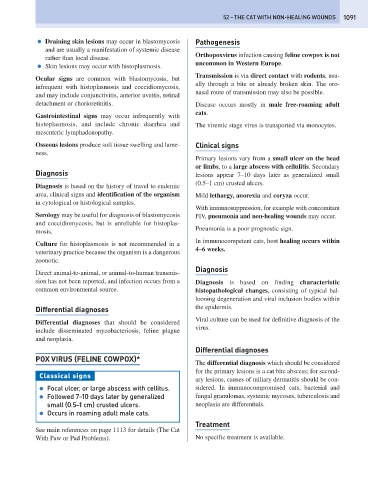Page 1099 - Problem-Based Feline Medicine
P. 1099
52 – THE CAT WITH NON-HEALING WOUNDS 1091
● Draining skin lesions may occur in blastomycosis Pathogenesis
and are usually a manifestation of systemic disease
Orthopoxvirus infection causing feline cowpox is not
rather than local disease.
uncommon in Western Europe.
● Skin lesions may occur with histoplasmosis.
Transmission is via direct contact with rodents, usu-
Ocular signs are common with blastomycosis, but
ally through a bite or already broken skin. The oro-
infrequent with histoplasmosis and coccidiomycosis,
nasal route of transmission may also be possible.
and may include conjunctivitis, anterior uveitis, retinal
detachment or chorioretinitis. Disease occurs mostly in male free-roaming adult
cats.
Gastrointestinal signs may occur infrequently with
histoplasmosis, and include chronic diarrhea and The viremic stage virus is transported via monocytes.
mesenteric lymphadenopathy.
Osseous lesions produce soft tissue swelling and lame- Clinical signs
ness.
Primary lesions vary from a small ulcer on the head
or limbs, to a large abscess with cellulitis. Secondary
Diagnosis lesions appear 7–10 days later as generalized small
(0.5–1 cm) crusted ulcers.
Diagnosis is based on the history of travel to endemic
area, clinical signs and identification of the organism Mild lethargy, anorexia and coryza occur.
in cytological or histological samples.
With immunosuppression, for example with concomitant
Serology may be useful for diagnosis of blastomycosis FIV, pneumonia and non-healing wounds may occur.
and coccidiomycosis, but is unreliable for histoplas-
Pneumonia is a poor prognostic sign.
mosis.
In immunocompetent cats, host healing occurs within
Culture for histoplasmosis is not recommended in a
4–6 weeks.
veterinary practice because the organism is a dangerous
zoonotic.
Diagnosis
Direct animal-to-animal, or animal-to-human transmis-
sion has not been reported, and infection occurs from a Diagnosis is based on finding characteristic
common environmental source. histopathological changes, consisting of typical bal-
looning degeneration and viral inclusion bodies within
Differential diagnoses the epidermis.
Viral culture can be used for definitive diagnosis of the
Differential diagnoses that should be considered
virus.
include disseminated mycobacteriosis, feline plague
and neoplasia.
Differential diagnoses
POX VIRUS (FELINE COWPOX)*
The differential diagnosis which should be considered
for the primary lesions is a cat bite abscess; for second-
Classical signs
ary lesions, causes of miliary dermatitis should be con-
● Focal ulcer, or large abscess with cellitus. sidered. In immunocompromised cats, bacterial and
● Followed 7–10 days later by generalized fungal granulomas, systemic mycoses, tuberculosis and
small (0.5–1 cm) crusted ulcers. neoplasia are differentials.
● Occurs in roaming adult male cats.
Treatment
See main references on page 1113 for details (The Cat
With Paw or Pad Problems). No specific treatment is available.

